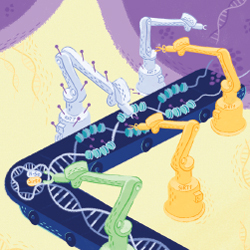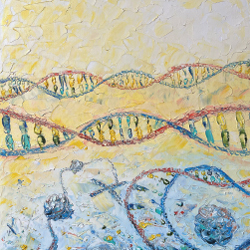SIRT1 Promotes T-ALL Progression Downstream of NOTCH1 via KAT7

Activated NOTCH1 is a common driver of T-cell acute lymphoblastic leukemia (T-ALL). Due to the toxicity of and resistance to NOTCH1 inhibitors, therapies targeting molecules downstream of NOTCH1 might help treat relapsed patients. In this study, Lancho et al. reveal that NOTCH1 directly activates SIRT1 transcription through a distal enhancer element. Genetic loss or inhibition of SIRT1 leads to significant antileukemic effects in mouse models with different SIRT1 allelic dosages. Mechanistically, the oncogenic effects of SIRT1 are mediated, at least in part, by its deacetylation and activation of KAT7. These results uncover the therapeutic potential of SIRT1-KAT7 axis inhibition in T-ALL. ■
ETV6 Loss Unlocks ERG-Activated GGAA Enhancers in ETV6-RUNX1+ B-ALL

The regulatory targets of the ETS repressor ETV6, a candidate tumor suppressor in B-lymphoblastic leukemia (B-ALL), have remained poorly understood. Kodgule, Goldman, Monovich et al. show that ETV6 binds to genomic short tandem repeats of the sequence ‘GGAA’ that are repressed in normal hematopoietic cells and other tissues. In ETV6-RUNX1+ B-ALL and other B-ALL with ETV6 inactivation, these repeats are bound instead by the ETS activator ERG, take on a cancer-specific enhancer-like chromatin state resembling that seen in Ewing sarcoma, and directly activate expression of B-ALL subtype-defining ETV6-RUNX1+/-like signature genes, including the candidate leukemia driver EPOR. ■
CLL-Derived Exosomes Inhibit Antitumor T-cell Responses In Vivo

Exosomes are important mediators of cell-to-cell communication in cancer but their implication in chronic lymphocytic leukemia (CLL) pathogenesis is unknown. Here, combining mouse genetic models and advanced purification methods to interrogate exosome secretion in vivo, Gargiulo et al. demonstrated that exosomes in the tissue microenvironment are indispensable for CLL progression by dampening antitumor immunity. Immunosuppressive effect of the exosomes on CD8 T cells is revealed by transcriptome, proteome, and metabolome profiling and functional interrogation. These include upregulation of inhibitory receptors, downregulation of effector molecules, impaired T-cell activation, proliferation, and cytotoxicity. In CLL patients, exosome-related gene expression correlates with poor survival and unfavorable clinical parameters. ■
DLBCL Mouse Models to Serve as Preclinical Platforms

Flümann et al. engineer a new generation of genetic mouse models of aggressive diffuse large B-cell lymphoma (DLBCL) where B-lineage restricted plasma cell differentiation-blocking Prdm1 or Spib aberrations are layered upon the Myd88/Bcl2 oncogenic background. By molecular profiling, Prdm1-deficient DLBCLs display features reminiscent of prememory and light-zone B cells, whereas lymphomas retaining Prdm1 are enriched for late light-zone and plasmablast-associated gene sets. Prdm1-deleted lymphomas respond to anti-PD1 immune-checkpoint blockade and anti–CD19-CAR T cells. Functional interrogation shows increased dependence of Prdm1-altered lymphomas on B-cell receptor signaling. Fittingly, these lymphomas display preclinical sensitivity against combined BTK/BCL2 inhibition. The efficacy of this regimen is validated in a series of 6 relapsed/refractory non-GCB DLBCL patient cases. ■


